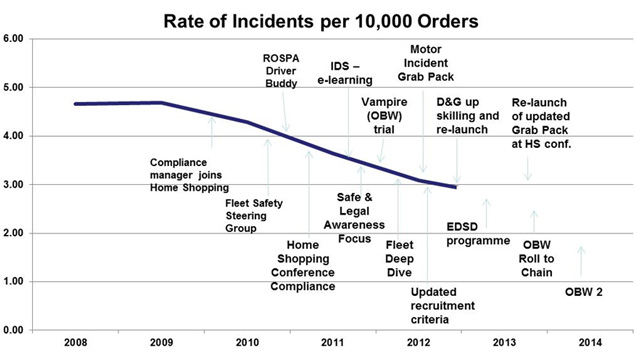Since 2010 the company has transformed its work-related road safety policies, programmes, processes and performance. Compliance, transport and safety managers were recruited who quickly identified the van fleet as a major risk and cost to the organisation and a Fleet Safety Steering Group (FSSG) was established. This has focused on a range of initiatives including:
- Working with RoSPA on a driver ‘buddy’ training programme.
- Utilising Virtual Risk Manager (VRM).
- Building road safety into the organisational DNA through management coaching and events. One excellent example is the short film below, developed for its management community to reinforce the importance of doing the right things to lead their drivers to safety.
- The One Best Way project.
- Fleet Auditing with FTA and more recently Zurich.
- Developing a motor ‘Grab-Pack’ to support collision reporting and investigation.
- Developing new Disciplinary and Grievance procedures for drivers.
- Targeted behind the wheel training courses for at-risk drivers with AADrivetech.
Internally Asda Home Shopping used the film to provide a standardised message to managers across its 200 plus locations across the UK. As part of its corporate social responsibility processes the film has also been shown at industry events hosted by the road safety charity Brake and the Freight Transport Association Van Excellence programme. It is now being shared more widely by Asda to help other organisations with ideas about engaging their managers.
VRM rollout
Partnering with eDriving saw the roll out of VRM. This included HR data requirements, DVLA checks, online risk assessment & coaching and a supporting risk data-warehouse which both rationalised and upgraded existing platforms. In 2011, IDS successfully passed Wal-Mart’s high security requirements becoming an integral part of our safety strategy and allowed DVLA licence checks to be made and, according to relative levels of risk, establish regular re-checks.
Early in 2012 the VRM eLearning assessment (including Privacy, Pledge, Risk Foundation and RoadRISK modules) was briefed out to all stores. Module compliance sits at >98% across all our current 6,000+ drivers. On-going work ensures the accuracy and robustness of HR and store structure data, as well as MIS access for all key stakeholders including central, regional and store based managers and coaches. The RoadRISK Defensive Driving module has also been developed to better support pre-recruitment decisions. More recently online RiskCOACH modules focusing on Winter Driving, Driver Attitude and Rural Road Safety have been rolled out, and the online programme re-launched to all drivers to reinforce policy and further promote good practice.
The programme described has yielded claim rate reductions against sales, vehicles and miles. In 2008, the incident rate per £1 million of sales revenue was 6, halving to 3 in 2012. This includes a reduction of 58% in the rate of ‘Found on inspection’ events during 2012, highlighting improvements in claims reporting and recording as well as safety performance. The graph below shows this progress as incidents per 10,000 orders against some of the key elements of the program. At the end of June 2013, the rate stood at 2.88 incidents per 10,000 orders.

ASDA HS sales (and hence the fleet size and number of drivers) continue to grow rapidly. Discussions focus on continuing to develop a management led integrated systems based approach, further building risk management into its organisational DNA.
Internally within ASDA, the logistics depots are developing a similar programme, and have increased their compliance on DVLA licence checks from 75% of drivers in 2012 to 99% now. The company car and FLT fleets are also trialling such an approach.
Externally ASDA has benchmarked its processes and outcomes through participation in the VRM benchmarking group.
As a result of the programme ASDA has received recognition in the form of several road safety awards.
![[logo]](https://www.edriving.com/wp-content/uploads/2016/10/250px_asda.png)
